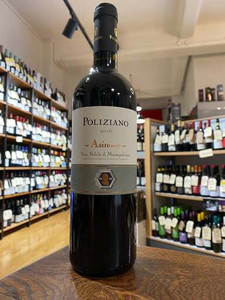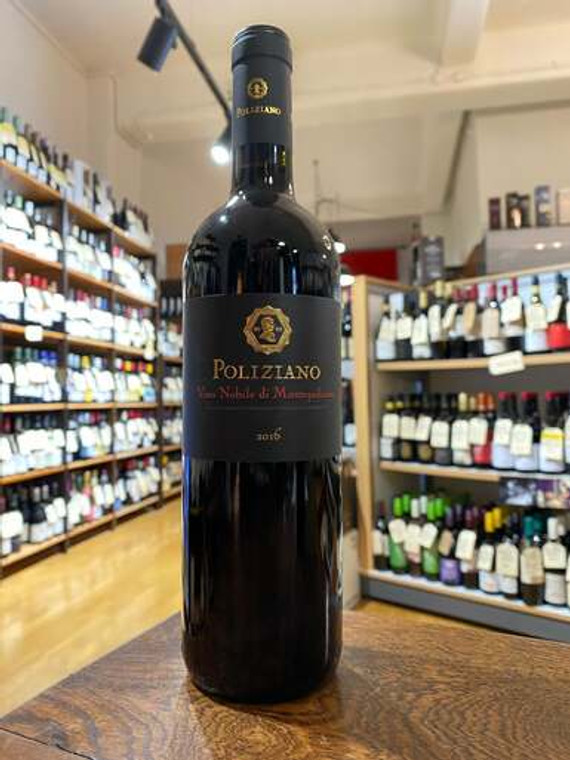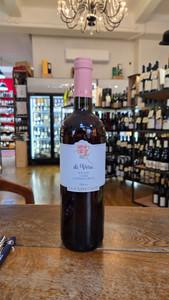
A gorgeous Sangiovese from the Tuscan town of Montepulciano (not to be confused with wines from the Montepulciano grape used in Abruzzo). The previous vintage of this wine made it to Wine Spectator’s Top 100 Wines of 2019 list (#54). Predominantly made from the local Sangiovese strain called Prugnolo Gentile, this superb red has a fleshiness and almost opulent expression that is simply delicious now, but has the structure to age gracefully.
Poliziano
Azianda Poliziano is a producer of top Sangiovese, called by Antonio Galloni "one of the reference points in Montepulciano." It was started in 1961 with an initial nucleus of 22 hectares. It has grown over the years to reach its present size of 120 hectares. Its name is an homage to the humanist poet Angelo Ambrogini (1454-1494), known as "Il Poliziano", who was born in Montepulciano. There are approximately 30 hectares of vineyards clustered around the winery's buildings as well as a number of individual properties that range in size from eight to thirty hectares. The vines are planted at altitudes ranging from 280 to 400m above sea level, with soil that is primarily volcanic clay and slightly rocky. The geological survey of the Comune of Montepulciano identifies the most important sections with the names: Asinone, Caggiole, Valiano, Lama, Casale and Pozzi.
Sangiovese
Until relatively recently Sangiovese, Italy's most widely planted vine variety, was a grape in the wilderness. And whenever the name Sangiovese did appear on a label it was far from a guarantee of greatness.
Perhaps the most exciting development in the recent dramatic upgrading of the reputation of Chianti, however, has had the side effect of suggesting that it was slack winemaking rather than any inherent shortcomings in the Sangiovese grown in Romagna, north-east of Tuscany, that was at fault.
Sangiovese is and has always been THE dominant grape of central Italian red wines, and Chianti in particular. Because in the mid-20th century Chianti was frequently lightened with the addition of tart, pale-skinned Trebbiano grapes and stretched by the addition of fuller reds imported in bulk from the south of Italy and the islands, it was far from easy to determine what Sangiovese's innate qualities were. It has been only in the last couple of decades, thanks to a systematic research programme by producers in the Chianti Classico heartland of the greater Chianti region, that the myriad clones of Sangiovese grown all over central Italy have been studied and assessed.
Sangiovese's dominant viticultural characteristics are that it can vary as much as Pinot Noir in its sensitivity to place and that it ripens relatively late. This means that if it is planted too high in Tuscany it can all too easily produce wine that is tart and unripe. The Chianti Classico research programme has concentrated on trying to match suitable clones to the varied local conditions of this quite extensive region whose upper reaches can be at the limit of successful grape-ripening territory. Many of the best producers deliberately try to have a range of different selections in their vineyards and therefore wines.
Today, fine Sangiovese is an altogether nobler wine. It will be the product of much lower yields so that there is real concentration of colour and savour. As for the elusive flavour of pure Sangiovese, it ranges in a spectrum somewhere between mulberries, prunes, spice, tobacco, sometimes leather and chestnuts (there seems to be some common thread of colour here!) It tends to be savoury rather than sweet, and if not fully ripe can smell distinctly farmyard-like.
Marchese Piero Antinori set in train a huge fashion for blending in Bordeaux grapes with the local Sangiovese when he released the then mould-breaking Tignanello in the early 1970s (mimicking the recipe for Carmignano on the other side of Florence). He also demonstrated that Sangiovese could cope with an entirely different ageing regime from the traditional practice of keeping it in large, old botti, upright casks of usually Slavonian oak and leaching the colour and guts out of it. Nowadays, many producers supplement or substitute for botti with much smaller barrels, typically made from French oak - just like the ones used in Bordeaux. This, just as much as anything else, has helped to make Chianti Classico a much more concentrated wine - although there are still too many that taste too obviously of oak and/or Cabernet Sauvignon.
And now that the right clones have been identified and are increasingly planted, Sangiovese is allowed to shine in all its glory without depending on make-up imported from Bordeaux. The much-amended regulations now allow producers to add a total of up to 25% (this may be reduced to 20%) of other varieties, but many of the finest wines are made entirely from Sangiovese. And if other grapes are added, they are today just as likely to be the traditional and local scented Mammolo, rather ordinary Canaiolo and/or the deep-coloured Colorino as Cabernet Sauvignon and Merlot - and since 2006 white grapes have been outlawed from Chianti Classico.
Perhaps the most famous selection of Sangiovese was first promulgated by Biondi Santi of the hilltop town of Montalcino in southern Tuscany in the late 19th century. This particularly deeply coloured, tannic selection is known as Brunello and thus Brunello di Montalcino, one of Italy's most noble and long-lived wines made entirely of this local vine speciality, was born. Brunello tends to need many more years in bottle to develop than even the sternest Chianti Classico but the DOC Rosso di Montalcino identifies the earlier maturing reds of the region.
Just to the east of Montalcino, around the town of Montepulciano, there is a similar system for the local wines, known as Vino Nobile di Montepulciano, whose local strain of Sangiovese is called Prugnolo Gentile. Quality here has been improving steadily of late, with Rosso di Montepulciano playing a similar role to its counterpart from Montalcino.





